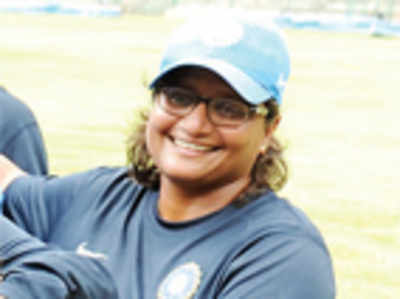Women on the move, but it’s still uphill

BENGALURU: When opener Thirush Kamini bludgeoned Anna Peterson for a boundary to bring up India’s series victory in the fifth and final one-dayer against New Zealand last week, it sparked scenes of ecstasy and jubilation in the Indian camp. Players ran on to the ground, dancing and whooping.
The win was hard-fought and although it came in a near-empty stadium, it marked another milestone in a long and hard journey for the country’s women’s team.
The series was telecast live — a rarity — and the Board of Control for Cricket in India was quick to announce a cash reward of Rs 21 lakh, a huge step up from the playing days of Purnima Rao, team coach and former captain. While Rao insists that there is still a long way to go before the women’s game comes on parity with the men, she admits that it has come a long way from the many sleepless nights she spent on railway platforms, dodgy hotels and even veterinary hospitals.
“Women cricketers had little or no financial benefits,” Rao told Mirror on Thursday. “We had to travel on our own. Our seniors like Shantha Rangaswamy even used to buy their own tickets if they had to go somewhere to play a match. We even spent nights in a vet hospital. So it’s thrilling to see that players now are financially secured.”
Much credit is due to the BCCI. Women’s cricket in the country was governed by the Women’s Cricket Association of India, but that changed in 2006 when it was merged with the BCCI. Yet, it was only in May this year when a contract system was proposed for the women’s team, similar to the grade-level payment that the men receive. Prior to that, women players were paid on match and series basis.
India captain Mithali Raj believes the contract system is a “big boost”. “It has come late, but it has come,” Raj said. “It will motivate young girls to take to cricket as a profession. It ensures security. If a player is injured and cannot afford treatment, the board takes care of it. When you have that kind of security, you play freely.”
Poor spectator turnout is something that has to change, says Rao. She remembers far bigger crowds in smaller venues. “I played in an era where even in Patna and Lucknow, people were thronging to watch us play,” Rao said. “Now we play in just one venue and there is no crowd. When I captained India in 1995, we had a series against Australia and England. We had large crowds in the stadiums.”
Raj wants more international exposure. “We should play more international games on a regular basis,” she said.
“Now, we don’t play till our tour of Australia, a good six months away (in Jan 2016). If there’s no continuity, people tend to forget.”
Both are hopeful that things will continue to improve. Rao feels the 2016 World T20, to be held in India, will generate interest. “The men will obviously get the larger share of the newspaper, but I feel after the semis, interest will kick in,” Rao said. “If we win the World Cup, then there will be a lot more interest like how the men’s team received when they won it in 1983.”
The win was hard-fought and although it came in a near-empty stadium, it marked another milestone in a long and hard journey for the country’s women’s team.
The series was telecast live — a rarity — and the Board of Control for Cricket in India was quick to announce a cash reward of Rs 21 lakh, a huge step up from the playing days of Purnima Rao, team coach and former captain. While Rao insists that there is still a long way to go before the women’s game comes on parity with the men, she admits that it has come a long way from the many sleepless nights she spent on railway platforms, dodgy hotels and even veterinary hospitals.
“Women cricketers had little or no financial benefits,” Rao told Mirror on Thursday. “We had to travel on our own. Our seniors like Shantha Rangaswamy even used to buy their own tickets if they had to go somewhere to play a match. We even spent nights in a vet hospital. So it’s thrilling to see that players now are financially secured.”
There is progress in other areas as well. “On the infrastructure front, training sessions are far more professional now,” Rao said. “The team has its own physio and video analyst. We didn’t have things like this back then. It’s bound to motivate players. While I’m glad that I played cricket for my country, I wouldn’t want that era back. I am happy to see this part of it.”
Much credit is due to the BCCI. Women’s cricket in the country was governed by the Women’s Cricket Association of India, but that changed in 2006 when it was merged with the BCCI. Yet, it was only in May this year when a contract system was proposed for the women’s team, similar to the grade-level payment that the men receive. Prior to that, women players were paid on match and series basis.
India captain Mithali Raj believes the contract system is a “big boost”. “It has come late, but it has come,” Raj said. “It will motivate young girls to take to cricket as a profession. It ensures security. If a player is injured and cannot afford treatment, the board takes care of it. When you have that kind of security, you play freely.”
Poor spectator turnout is something that has to change, says Rao. She remembers far bigger crowds in smaller venues. “I played in an era where even in Patna and Lucknow, people were thronging to watch us play,” Rao said. “Now we play in just one venue and there is no crowd. When I captained India in 1995, we had a series against Australia and England. We had large crowds in the stadiums.”
Raj wants more international exposure. “We should play more international games on a regular basis,” she said.
“Now, we don’t play till our tour of Australia, a good six months away (in Jan 2016). If there’s no continuity, people tend to forget.”
Both are hopeful that things will continue to improve. Rao feels the 2016 World T20, to be held in India, will generate interest. “The men will obviously get the larger share of the newspaper, but I feel after the semis, interest will kick in,” Rao said. “If we win the World Cup, then there will be a lot more interest like how the men’s team received when they won it in 1983.”
GALLERIES View more photos





















